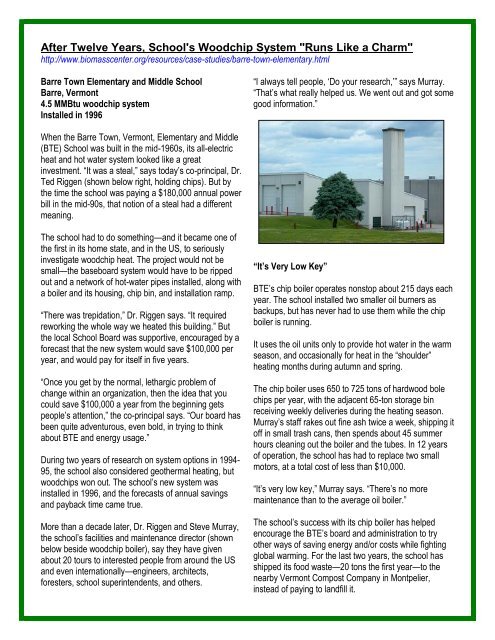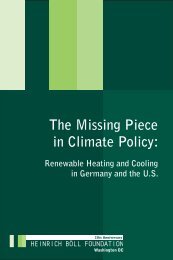Public Schools, long-term - Vermont
Public Schools, long-term - Vermont
Public Schools, long-term - Vermont
- No tags were found...
Create successful ePaper yourself
Turn your PDF publications into a flip-book with our unique Google optimized e-Paper software.
After Twelve Years, School's Woodchip System "Runs Like a Charm"<br />
http://www.biomasscenter.org/resources/case-studies/barre-town-elementary.html<br />
Barre Town Elementary and Middle School<br />
Barre, <strong>Vermont</strong><br />
4.5 MMBtu woodchip system<br />
Installed in 1996<br />
“I always tell people, ‘Do your research,’” says Murray.<br />
“That’s what really helped us. We went out and got some<br />
good information.”<br />
When the Barre Town, <strong>Vermont</strong>, Elementary and Middle<br />
(BTE) School was built in the mid-1960s, its all-electric<br />
heat and hot water system looked like a great<br />
investment. “It was a steal,” says today’s co-principal, Dr.<br />
Ted Riggen (shown below right, holding chips). But by<br />
the time the school was paying a $180,000 annual power<br />
bill in the mid-90s, that notion of a steal had a different<br />
meaning.<br />
The school had to do something—and it became one of<br />
the first in its home state, and in the US, to seriously<br />
investigate woodchip heat. The project would not be<br />
small—the baseboard system would have to be ripped<br />
out and a network of hot-water pipes installed, a<strong>long</strong> with<br />
a boiler and its housing, chip bin, and installation ramp.<br />
“There was trepidation,” Dr. Riggen says. “It required<br />
reworking the whole way we heated this building.” But<br />
the local School Board was supportive, encouraged by a<br />
forecast that the new system would save $100,000 per<br />
year, and would pay for itself in five years.<br />
“Once you get by the normal, lethargic problem of<br />
change within an organization, then the idea that you<br />
could save $100,000 a year from the beginning gets<br />
people’s attention,” the co-principal says. “Our board has<br />
been quite adventurous, even bold, in trying to think<br />
about BTE and energy usage.”<br />
During two years of research on system options in 1994-<br />
95, the school also considered geothermal heating, but<br />
woodchips won out. The school’s new system was<br />
installed in 1996, and the forecasts of annual savings<br />
and payback time came true.<br />
More than a decade later, Dr. Riggen and Steve Murray,<br />
the school’s facilities and maintenance director (shown<br />
below beside woodchip boiler), say they have given<br />
about 20 tours to interested people from around the US<br />
and even internationally—engineers, architects,<br />
foresters, school superintendents, and others.<br />
“It’s Very Low Key”<br />
BTE’s chip boiler operates nonstop about 215 days each<br />
year. The school installed two smaller oil burners as<br />
backups, but has never had to use them while the chip<br />
boiler is running.<br />
It uses the oil units only to provide hot water in the warm<br />
season, and occasionally for heat in the “shoulder”<br />
heating months during autumn and spring.<br />
The chip boiler uses 650 to 725 tons of hardwood bole<br />
chips per year, with the adjacent 65-ton storage bin<br />
receiving weekly deliveries during the heating season.<br />
Murray’s staff rakes out fine ash twice a week, shipping it<br />
off in small trash cans, then spends about 45 summer<br />
hours cleaning out the boiler and the tubes. In 12 years<br />
of operation, the school has had to replace two small<br />
motors, at a total cost of less than $10,000.<br />
“It’s very low key,” Murray says. “There’s no more<br />
maintenance than to the average oil boiler.”<br />
The school’s success with its chip boiler has helped<br />
encourage the BTE’s board and administration to try<br />
other ways of saving energy and/or costs while fighting<br />
global warming. For the last two years, the school has<br />
shipped its food waste—20 tons the first year—to the<br />
nearby <strong>Vermont</strong> Compost Company in Montpelier,<br />
instead of paying to landfill it.
An energy consulting firm, working with the school over<br />
the first half of 2008, helped it save over $10,000 in<br />
energy costs, trimming its bill by almost 14 percent—and<br />
cutting its production of carbon dioxide by 16 percent, or<br />
about 90,000 pounds, according to a June 29, 2008<br />
article in the Barre-Montpelier Times Argus.<br />
Barre Town owns an 88-acre forest, and the school<br />
recently was involved with the county forester in a<br />
project that saw the woodland logged, some of the culled<br />
wood chipped for the school’s bin, and a multi-year<br />
management plan developed.<br />
“It takes a whole community, both people and<br />
professionals, to think these things through,” Dr. Riggen<br />
says. “The role of the school becomes to coordinate this.<br />
If you can get that kind of synergy going in an<br />
organization, to see things in a different way, you can<br />
achieve a great end.”<br />
And, in a school setting, there is an educational benefit<br />
as well. Dr. Riggen, who has a forestry background,<br />
recently visited a fourth-grade class. Holding a large<br />
maple bole, with one small branch still on it, he was<br />
asked what that wood was made of.<br />
“Well, it’s made of carbon,” he recalls saying. “Where<br />
does every bit of carbon come from It only has one<br />
source. Every wood atom, and every woodchip, comes<br />
from CO2—and CO2 is the enemy, with regard to global<br />
warming. We’re promoting the growth of trees by finding<br />
a use for them, and the growth of trees reduces the CO2<br />
in the atmosphere. They capture the carbon.”<br />
In the boiler house, Murray says the chi p system has<br />
been “good for the school, and good for the community. I<br />
grew up on a farm, and to me it’s just another way of<br />
burning wood. But the impact ...”<br />
He shrugs. The impact is still widening, like ripples on a<br />
very large pond.<br />
“When people come here for a tour, I give it to ‘em<br />
straight,” Murray says. “This is not a chain around our<br />
neck. Nobody has complained about a smell, or anything<br />
like that. This thing runs like a charm.”






